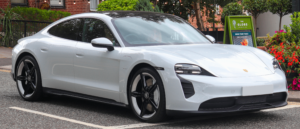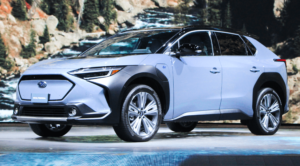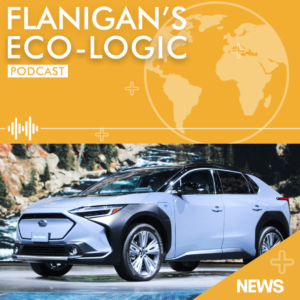In This Issue
- Flanigan’s Eco-Logic: Join the EV Revolution!
- Texas to Become #1 Utility-Scale Solar State
- Solar/Storage Peaker Plant
- Seaweed and GMO-Tree Sequestration
- Upcycling Buildings in Norway
- REI Puts a Stop to PFAS Chemicals
- Flanigan’s Ego-Logic Podcast Updates

Flanigan’s Eco-Logic: Join the EV Revolution!
“NFW” was the remark that a great friend made a few months ago over a lively dinner conversation in New York. I had enthusiastically proclaimed to Brian’s wife that we’d all have EVs in five years. Same with solar and batteries. Brian may be right. I may well have overstated my claim in my zeal for the greening of mobility and our homes. But we bet nonetheless… me taking a position that I hope I win for the sake of the planet. For all of us.
It’s time to get an EV! They are fun to drive and are a big step in protecting our environment. Now EV range has increased, choices abound, and the costs are being driven down. The average cost of an EV in America in January was $58,725. But stay tuned. This is dropping in real time, and will so precipitously.
What’s amazing is the pace at which new EVs are entering the marketplace. There are super-high-end EVs from Lucid and Fisker and Porsche… to budget brands like Kia, Chevrolet, Ford, Nissan, and VW. In between are Mercedes, Cadillac, Volvo, BMW, Audi, and a host of others vying for EV market share. While way out ahead of the pack, Tesla is now feeling the competition, having to slash prices in the last quarter of 2022.

The field is broad and in some ways bizarre. Bentley is planning to introduce its first EV in 2025, a car that will be able to go from 0 – 60 in 1.5 seconds. Gads! What an example of the instantaneous torque presented by electric power trains. (Tesla Model S Plaid does this in 1.9 seconds.) The Bentleys will be built in Crewe, England and will have “twice as much grunt” as the Bentley twin turbocharged, 650 hp GT Speed.
Back to more affordable varieties. As previously reported, the Porsche Group which owns Volkswagen, has stated its ambition to take over Tesla’s distinction as the number one EV maker in the world. VW has branded its “ID” line as its EV line. Now it’s recrafting its compact and popular Golf to be all-electric and to be launched as the ID 2.
Some say that Hyundai “knocked it out of the park” with the futuristic Ioniq 5 car. Hyundai is planning to roll out the Ioniq 6 this spring. The $45,500 sedan will get up to 361 miles on a single charge. A lower-cost version – $42,990 – will get 272 miles per gallon. A drawback is that the Ioniqs, and others such as the Kia EV6, are not eligible for the federal tax credit as they are not built in the United States. You gotta watch that! Some VW ID4s are made in German and do not qualify, while others made in Tennessee do! And stay tuned: In March the IRS is scheduled to announce new rules. EVs with batteries manufactured outside of the U.S. will likely not be eligible for the tax credit.
Now Subaru joins the pack with its EV Solterra line. Its $44,995 premium version electric SUV has a 72.8 kWh battery bank. It’s the first EV SUV with “standard symmetrical” all-wheel drive. It features 8.3 inches of ground clearance. Its “Limited” and “Touring” models are more expensive, $48,485 and $51,995 respectively.

The EV action is also hot overseas. The Chinese BYD is now the leading EV seller in China, India, and New Zealand… and recently became the leading EV seller in Thailand. BYD’s ATTO 3 was the leading car sold. It sold for $35,400 (USD) in Thailand. Fully eight of the top ten EVs sold in Thailand last year were Chinese, including Volvo which was purchased by the Zhejiang Geely Holding Group from Ford in 2010.
Ford is working on its goal of producing 2 million EVs globally each year. It has now partnered with LG Energy Solution and Koc Holdings to develop a battery facility for EVs near Ankara, Turkey. Construction is expected to break ground this year on what will be one of Europe’s largest battery plants. The factory is slated for full production by 2026 and will be capable of producing 35 – 45 GWh of battery energy storage. Ford has successfully rolled out three EVs: the Mach E, Mach E GT, and E Transit. Last year, Ford announced that it would be an all-electric car company in Europe by 2035.
Note that all EVs are not created equal in terms of efficiency: My Chevy Bolt and Terry’s Tesla get about 4 miles/kWh. But when you see a large pick-up – the Rivian or Ford Lightning on the road – think more like 2 miles/kWh. While more efficient than internal combustion engine (ICE) vehicles, Amory Lovins calls these “brute-force” applications of electric mobility. And the more brutish, the heavier the vehicle, and the less efficiency and range. Stellantis, formed by the merger of Chrysler Fiat and Peugeot, will now be electrifying its Jeep and Ram brands. These will be heavy, inherently less efficient EVs. Inversely, keep an eye out for Apterra’s EV! It is slated to get 10 miles per kWh, its batteries replenished with solar cells in its roof.
So Brian, and all my friends, take your pick! There are so many choices. The number of non-Tesla EVs increased by 155% in 2022; fully 269% in the fourth quarter compared to the fourth quarter in 2021. Get ready for the next time you need a car. Yes, it’s time to test drive an EV… be it a Lexus, Lucid, Rivian, Tesla, Polestar, VW, Ford, or another market entrant! Get ready to make the shift. You in? We are a two-EV household. We have clean and efficient, solar-powered mobility and love being part of the climate solution.










